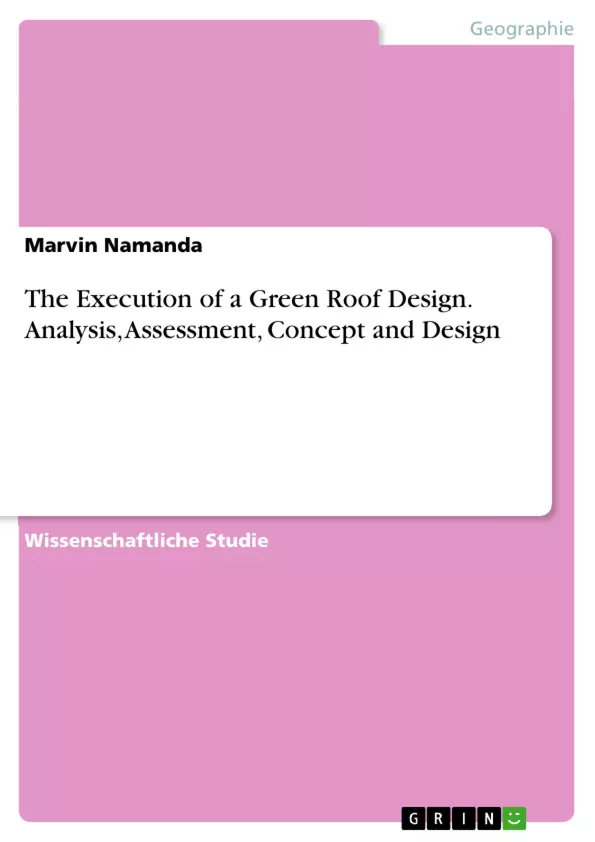This paper presents a green roof design where the client requires a specially engineered rooftop that supports plant life, measuring 37m by 44m. They requested a rooftop with a thin layer of low-growing, herbaceous plants that require low maintenance, thus an extensive green roof. The roof had to be a multi-layered build up consisting of a protection fleece layer and a recycled filter fleece under a loose blend of organic and mineral substrate under a planted sedum vegetation. Given the Australian climate, the plants should be densely spaced and able to live in meager soil and also survive exposure to cold, heat, and wind.
Inhaltsverzeichnis (Table of Contents)
- Part 1: Client Brief and Site Analysis
- Client Brief
- Anticipated Outcomes for the green roof
- Feasibility Analysis of the Outcomes
- Storm Water Management
- Air and Noise Pollution Reduction
- Heating and Cooling Mechanism for the building
- Reducing the Urban Heat Island
- Extension of roof life span
- Assessment of the Environmental, Social, and Economic Impacts of the Green Roof
- Technology
- Introduction
- Construction Phase
- Negative Impacts
- Positive Impacts
- Operation Phase Impacts
- Negative Impacts
- Positive Impacts
- Part 2: Concept Design
- Introduction
- Technical and Habitat Considerations
- Habitat
- Botanical Name
- Common Name
- Figure 2 Plan View Scale 1:76
- Figure 3 Plan View Key
- Figure 4 Horizontal View of the extensive green roof's material layers
- Figure 5 Final Model of the green roof on the building
- Planting Schedule
- Maintenance Schedule for Robin's Center Green Roof Systems
- Spring Schedule
- Autumn Schedule
- References
Zielsetzung und Themenschwerpunkte (Objectives and Key Themes)
Diese Arbeit befasst sich mit der Planung und Umsetzung eines begrünten Daches für das Robin Center in Collingwood, Australien. Das Ziel ist es, die Umweltfreundlichkeit des Gebäudes zu verbessern und gleichzeitig die ästhetischen und funktionalen Aspekte des Daches zu berücksichtigen.
- Bewertung der umweltbezogenen, sozialen und wirtschaftlichen Auswirkungen begrünter Dächer
- Analyse der Funktionen des begrünten Daches, einschließlich der Steuerung des Abflusses von Regenwasser, der Reduzierung der Wärmeinsel-Effekte, der Luft- und Lärmbelastung sowie der Wärmedämmung
- Entwicklung eines Konzeptdesigns, das die technischen Aspekte und die Lebensraum-Anforderungen berücksichtigt
- Präsentation des endgültigen Designs, einschließlich der Pflanzpläne und des Wartungsplans
- Bewertung der langfristigen Nachhaltigkeit und der Auswirkungen des begrünten Daches auf die Umwelt
Zusammenfassung der Kapitel (Chapter Summaries)
Part 1: Client Brief and Site Analysis
Dieser Abschnitt beschreibt die Anforderungen des Kunden an ein begrüntes Dach, die erwarteten Ergebnisse und die Machbarkeitsanalyse der verschiedenen Funktionen. Es werden die ökologischen, sozialen und wirtschaftlichen Auswirkungen des Projekts bewertet. Die wichtigsten Themen sind die Steuerung des Abflusses von Regenwasser, die Reduzierung der Luft- und Lärmbelastung sowie die Wärmedämmung.
Part 2: Concept Design
Dieser Abschnitt befasst sich mit den technischen Aspekten und den Lebensraum-Anforderungen, die bei der Gestaltung des begrünten Daches berücksichtigt werden müssen. Es werden die wichtigsten Pflanzenarten ausgewählt, die für das australische Klima geeignet sind.
Part 3: Final Design
Dieser Abschnitt präsentiert das endgültige Design des begrünten Daches, einschließlich der Pflanzpläne, des Wartungsplans und der technischen Details. Es werden die verschiedenen Materialien und Schichten des Daches beschrieben.
Schlüsselwörter (Keywords)
Begrüntes Dach, Nachhaltigkeit, Umweltfreundlichkeit, Regenwassermanagement, Wärmeinsel-Effekt, Luft- und Lärmbelastung, Lebensraum, Pflanzenarten, Design, Planung, Wartung, Australien.
- Quote paper
- Marvin Namanda (Author), 2015, The Execution of a Green Roof Design. Analysis, Assessment, Concept and Design, Munich, GRIN Verlag, https://www.grin.com/document/317908



